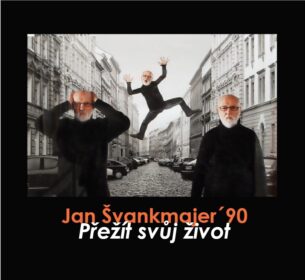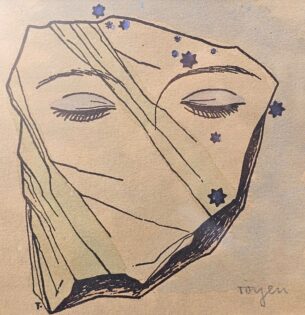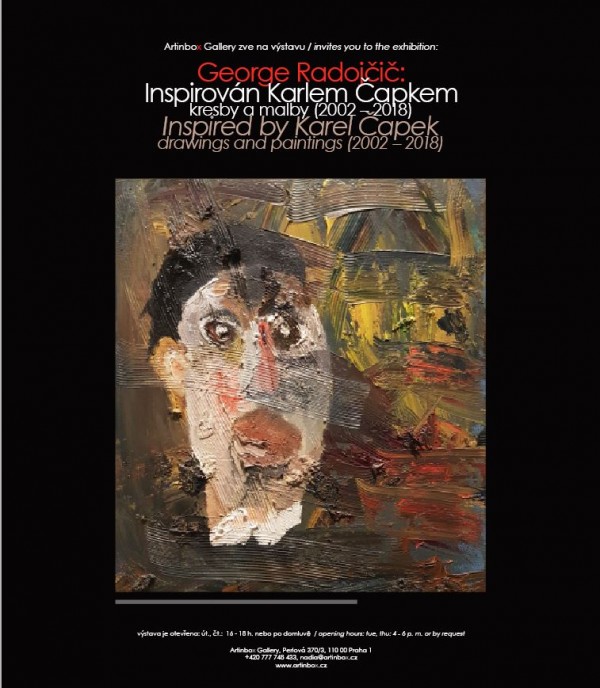GEORGE RADOJČIČ
Galerii fotografií z akce na facebooku můžete vidět zde: https://www.facebook.com/pg/ArtinboxGallery/photos/?tab=album&album_id=1844481205624559
Rozhovor pro Český rozhlas Karla Oujezdského s autorem Georgem Radojčičem a kurátorkami výstavy Nadiou Rovderovou a Terezií Zemánkovou si můžete poslechnout zde, od 14:40 – 20:00 minuty: http://prehravac.rozhlas.cz/audio/3999924
———————————————————–
Velké a malé příběhy George Radojčiče
George Radojčič se narodil do umělecké rodiny 28. března 1987 v Sarajevu, jako prvorozený syn české herečky Jany Radojčičové (roz.Kulendové) a bosenského režiséra a scénáristy Bora Radojčiče. George se narodil s mentálním handicapem. Ve čtyřech letech se u něho projevily záchvaty epilepsie, nemoc mu začala ničit rozvíjející se mozek. Byla mu diagnostikována vzácná forma epilepsie – Landau-Kleffnerův syndrom, takže po zbytek života musí být pod dohledem dospělé osoby. Narodil se ovšem i s mimořádným výtvarným talentem. Od raného dětství dával přednost kreslení a malování před hrou s jinými dětmi, ale i před jídlem či odpočinkem. Dokreslit či domalovat obrázek stálo vždy na prvním místě. Krátce po Georgově narození se rodina přestěhovala z válkou sužované Jugoslávie do Janina rodného Československa. První Georgovy kresby v předškolním věku byly ovlivněny kulisami Prahy a pobytem u příbuzných na Šluknovsku. Události v bývalé Jugoslávii zanechaly silné stopy v citlivém vnímání Gerge, v jeho tvorbě se často objevuje téma války, boj dobra a zla…
Základní vzdělávání v Praze prožíval George zpočátku velmi bolestně. Pro svou specifickou povahu si zažil nepochopení, šikanu a týrání od spolužáků i učitelů, což mu hned v první třídě přivodilo částečné ochrnutí. Vystřídal tři různé školy, než konečně ve 3. třídě našel zázemí v Církevní škole sester Voršilek, kam nastoupili
i jeho mladší bratr a sestra. Jeho spontánní povaha a přímé, bezprostřední jednání se zde setkaly s pochopením učitelů, byl přijat i spolužáky. Georgovi v letech 1997 – 2003 uspořádali několik školních výstav v Galerii na schodech. Potkal zde svého asistenta, pak dlouholetého přítele Stefana Berece, který se mu citlivě věnoval, pomáhal mu s tvorbou i vzděláváním. Seznámil ho mj. s dílem Karla Čapka, kterého si George zamiloval. Čapek Georgovi učaroval vnímáním dobra a zla, vnitřní morální sílou a soucitem s lidským utrpením. Později George vytvořil pozoruhodnou rozsáhlou sérii ilustrací k Čapkovu dílu. V jedenácti letech došlo u Georga ke zhoršení kognitivních funkcí a delší dobu byl hospitalizován na motolské neurologii v Praze. Přes všechny útrapy, si však i díky víře uchoval pozitivní pohled na život, snažil se odpouštět a chápat. Tento přístup k životu je rovněž silně zastoupen v jeho obrazech. Po skončení občanské války v bývalé Jugoslávii rodina znovu začala v letních měsících jezdit do chorvatské Murvice na ostrově Brač. Zde vznikly první tematicky ucelené soubory barevných kreseb a maleb moře, krajiny, vesnic. George nikdy složitě nehledal inspiraci, vystačil si s tím, co viděl kolem sebe, s tématy běžného života, či virtuálním světem masmédií nebo počítačových her. Maloval své blízké, ale i postavy literární, či historické, osobnosti ze světa politiky, biblické výjevy, postavy světců, démonů, andělů i modlících se postav. Svět v jeho podání je harmonický i násilný, fascinující i všední až lapidární. Nikdy však nudný.
V červnu 2004 ukončil George povinnou školní docházku a tento zlom v jeho životě provázela první velká výstava talentovaného mladíka mimo školu, v prestižní galerii „Nová síň“ ve Voršilské ulici v Praze. Sedmnáctiletý George byl následně neformálně, bez nároku na diplom, přijat na pražskou výtvarnou akademii do grafického ateliéru Doc. Jiřího Lindovského. Zde jeho talent nalezl docenění, narostlo mu sebevědomí, byl obdivován a chráněn, učil se novým výtvarným postupům. Zároveň však rostlo napětí, někteří si kladli otázku, jak je možné, že ten, kdo neumí pořádně psát, číst, počítat, či dospěle myslet, má výtvarný dar? Pak došlo ke střetu se spolužákem a George už nemohl být ponechán bez dozoru. Od té doby ho musela do ateliérů akademie vždy doprovázet matka. To se postupně stávalo časově neúnosné. Rodina se v té době stěhovala na okraj Prahy do Slivence, do domu se zahradou. Při přestavbě vybudovali Georgovi pokoj – ateliér. George odešel z AVU a začal pracovat doma. Limitován nemocí zůstal odkázán na pomoc matky – pomáhala mu napínat plátna, šepsovat, ořezávat tužky, učila ho překonávat handicap, bojovat a neztrácet naději. V roce 2010 začal George chodit do praktické školy pro handicapované žáky. Byl šťastný, že může sportovat, opakoval si čtení, psaní, matematiku, chodil na výlety do přírody a nadále tvořil. V roce 2013 měl úspěšnou autorskou výstavu „Georgovy zahrady a jiné“ v galerii Artinbox v centru Prahy, následně se za galerii účastnil i prohlídek umění Art Prague v Kafkově domě v Praze. Odměnou mu byla cesta do Říma a Asissi, poté poprvé v životě let letadlem – do Lurd. Následovalo několik menších autorských a skupinových výstav. George se stal kmenovým autorem galerie Artinbox, na jaře 2015 zde měl druhou samostatnou výstavu pod názvem „Příběhy“. Varianta této výstavy s důrazem na duchovní témata byla začátkem léta 2015 vystavena na ochozu kostela sv. Ignáce v rámci Dnů víry. V tomto kostele začal George každou neděli ministrovat. V roce 2015 a 2016 bylo v postní době v Dušičkové kapli kostela sv. Ignáce vystaveno Georgovo plátno „Pokušení Ježíše na poušti“ – u farníků tak vešlo do povědomí, že jejich ministrant, má „dar“. George rovněž začal pravidelně vystavovat ve sliveneckém kostelíčku Všech Svatých v rámci „Noci kostelů“, a nacházel si tak další přátele. Když jde na procházku se psem, lidé ho na ulici zdraví, povídají si s ním, zvou ho na čaj, či do kina. To je pro Georga moc důležité, už není „bezejmenným bláznem“. Tvorba tak Georgovi přinesla nejen radost z tvoření, ale následně i plnoprávné přijetí do společenství. Jeho obrazy přinášejí radost a naději nám.
Nadia Rovderová
Big and Small Stories of George Radojćić
George Radojćić was born into an artistic family on March 28, 1987 in Sarajevo, as the firstborn son of Czech actress Jana Radojćićová (née Kulendová) and Bosnian director and screenwriter Bora Radojćić. George was born with a mental handicap. At the age of four, he started having epileptic seizures, and the illness began to destroy the developing brain. He was diagnosed with a rare form of epilepsy – Landau-Kleffner syndrome, so for the rest of his life he must be under adult supervision. However, he was also born with an extraordinary artistic talent. From early childhood he preferred drawing and painting not only to playing with other children, but also to eating or relaxing. Finishing drawing or painting a picture always came first. Shortly after George’s birth the family moved from the war-torn Yugoslavia to Jana’s native Czechoslovakia. George’s first preschool age drawings were influenced by the Prague scenery and a stay with his relatives in the Šluknovsko region. The events in the former Yugoslavia left significant traces in George’s sensitive
perception; in his work the theme of war or the struggle between good and evil often reoccurs…
Elementary education in Prague was initially a very painful experience for George. Because of his specific nature he experienced misunderstanding, harassment and bullying from classmates and teachers, which
in the first class brought on his partial paralysis. He had changed schools three times before he finally found a haven in the third class at the Church School of Ursuline Sisters, which his younger brother and sister joined as well. His spontaneous nature and direct, immediate behaviour were here met with understanding from the teachers, and his classmates accepted him, too. Between 1997 and 2003, they organized several school exhibitions for George at the Gallery on the Stairs. Here he met his assistant and then a long-time friend
Stefan Berec, who took sensitive care of him, helped him with his work and education. He introduced him to, among other things, the work of Karel Čapek, with whom George fell in love. Čapek captivated George with his perception of good and evil, inner moral strength and compassion for human suffering. Later George created a remarkable extensive series of illustrations for Čapek’s work. At the age of eleven, George incurred deteriorating of cognitive functions and was for a longer time hospitalized at the Neurology Department of Motol Hospital in Prague. Despite all the hardship, he with faith still kept a positive outlook on life, trying to forgive and understand. This approach to life is also heavily represented in his paintings. After the end of the civil war in the former Yugoslavia, the family started again to travel in the summer to Croatian Murvica on the island of Brač. Here originated the first thematically compact series of colour drawings and paintings of the sea, countryside and villages. George never looked for inspiration intricately, he made do with what he saw around him, with themes of everyday life, or the virtual world of the mass media or computer games. He painted his loved ones, but also literary or historic figures, personalities from the world of politics, biblical scenes, figures of saints, demons, angels, and praying figures. In his interpretation the world is both harmonious and violent, fascinating and mundane, or even lapidary. But never boring.
In June 2004, George completed compulsory schooling and this turning point in his life was accompanied by the first major exhibition of the talented young man out of school, at the prestigious gallery “New Hall”
in Voršilská street in Prague. The seventeen year-old George was subsequently informally, without the right to a diploma, accepted to the Prague Art Academy in the graphic studio of Doc. George Lindovský. Here his
talent found appreciation, his confidence grew, he was admired and protected, learning new art techniques. Yet, the tension was rising and some wondered how it was possible that one who could not properly write, read, count, or think maturely, had a creative gift. Then there was a conflict with a classmate and George could not be left unattended. Since then he always had to go to the studios of the Academy accompanied by his mother. This gradually became too time demanding. At that time, the family moved to the outskirts of Prague in Slivenec, to a house with a garden. During reconstruction they built a room for George – a studio. George left the Academy and began working at home. Limited by the illness he remained dependent on the help of his mother – she helped him stretch canvases and coat them, crop pencils, taught him to overcome the handicap, fight and not lose hope. In 2010, George began to go to a vocational school for disabled pupils. He was happy that he could do sports, repeat reading, writing and mathematics, he went on trips and kept working. In 2013, he had a successful solo exhibition “George’s Gardens and More” at the Artinbox gallery in the centre of Prague, then he, represented by the gallery, participated in the art festival Art Prague in Kafka House in Prague. His reward was a trip to Rome and Assisi, and then the first time ever airplane flight – to Lourdes. Several smaller solo and group exhibitions followed.
George became permanently represented by the Artinbox gallery, and in spring 2015 his second solo exhibition entitled “Stories” was held here. A variant of this exhibition with an emphasis on spiritual subjects was shown in early summer of 2015 in the ambulatory of St. Ignatius Church during the Days of Faith. In this church George is now a ministrant every Sunday. In 2015 and 2016 during Lent, George’s canvas “The Temptation of Jesus in the Wilderness” was exhibited in the Chapel of All Souls at St. Ignatius Church – the parishioners thus became aware that their ministrant has a “gift”. George also began to exhibit regularly in Slivenec’s Church of All Saints during the “Church Nights”, and this way found more friends. When going for a walk with his dog, people on the street say hi, talk to him, invite him to tea, or to the cinema. It is very important to George, he is no longer a “nameless fool”. Artistic work has thus brought George not only joy of creating, but subsequently also fully-fledged acceptance into the community. His paintings bring joy and hope to us.
Nadia Rovderová



